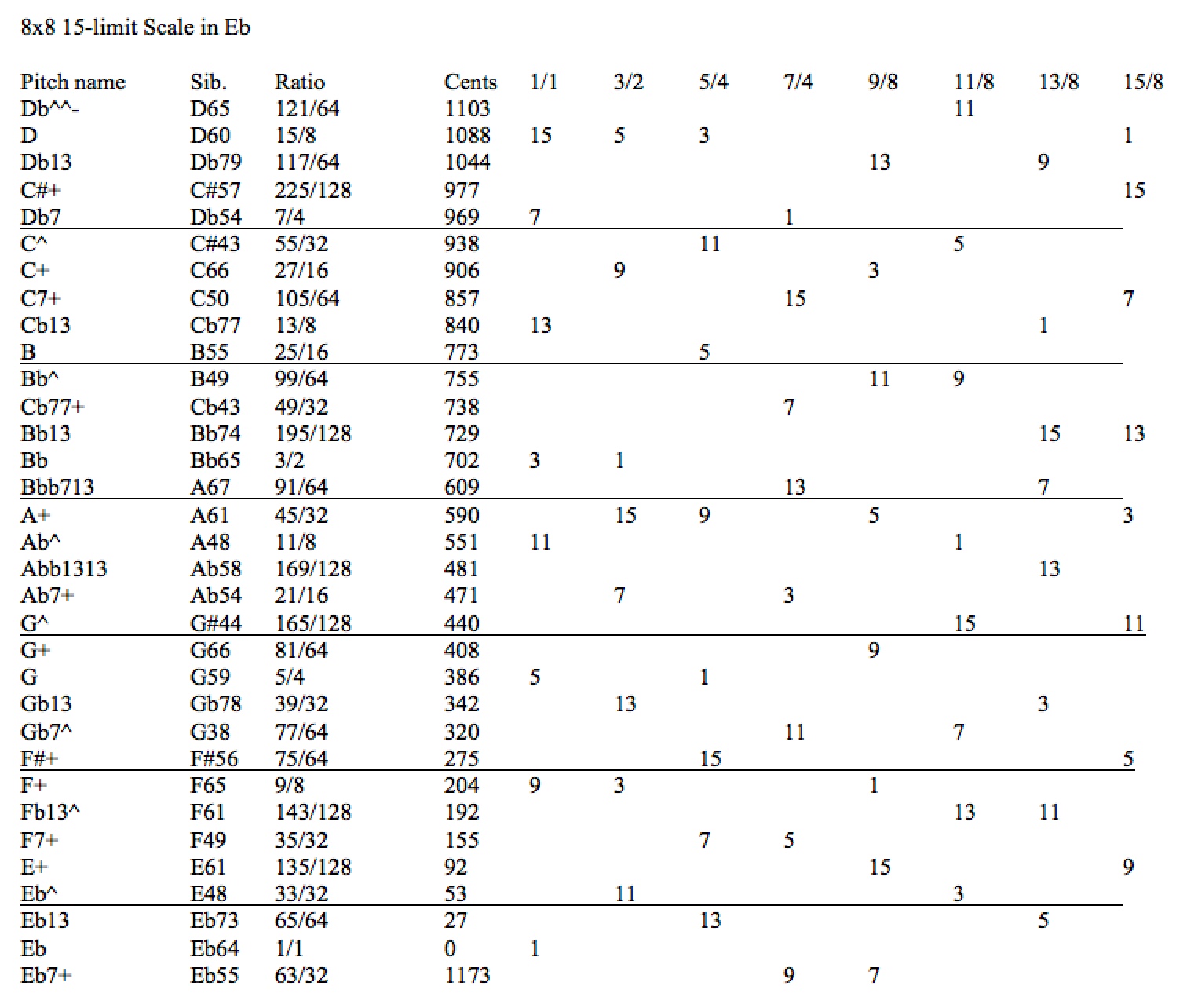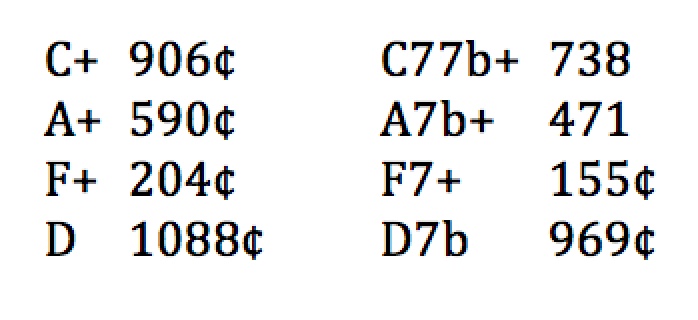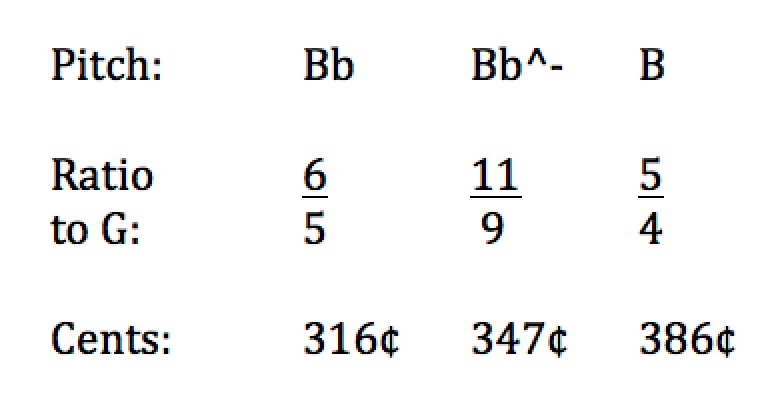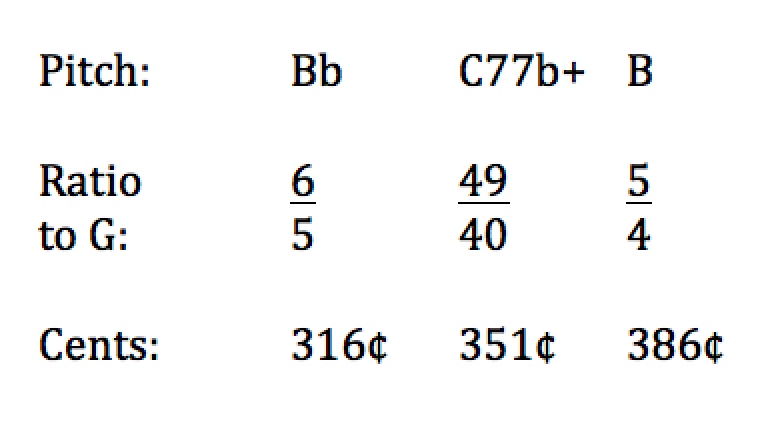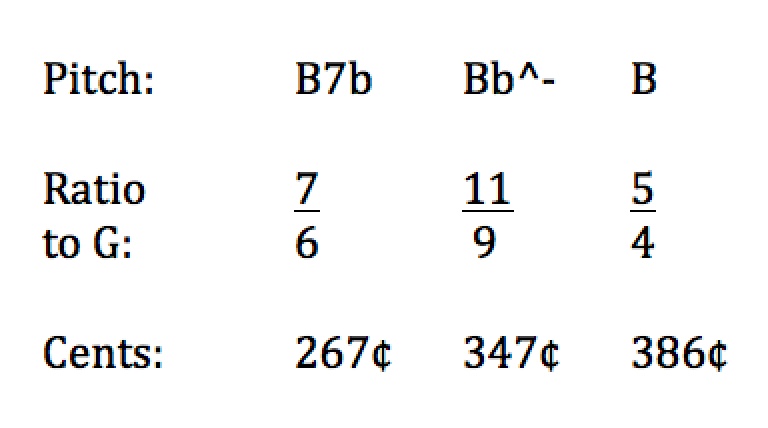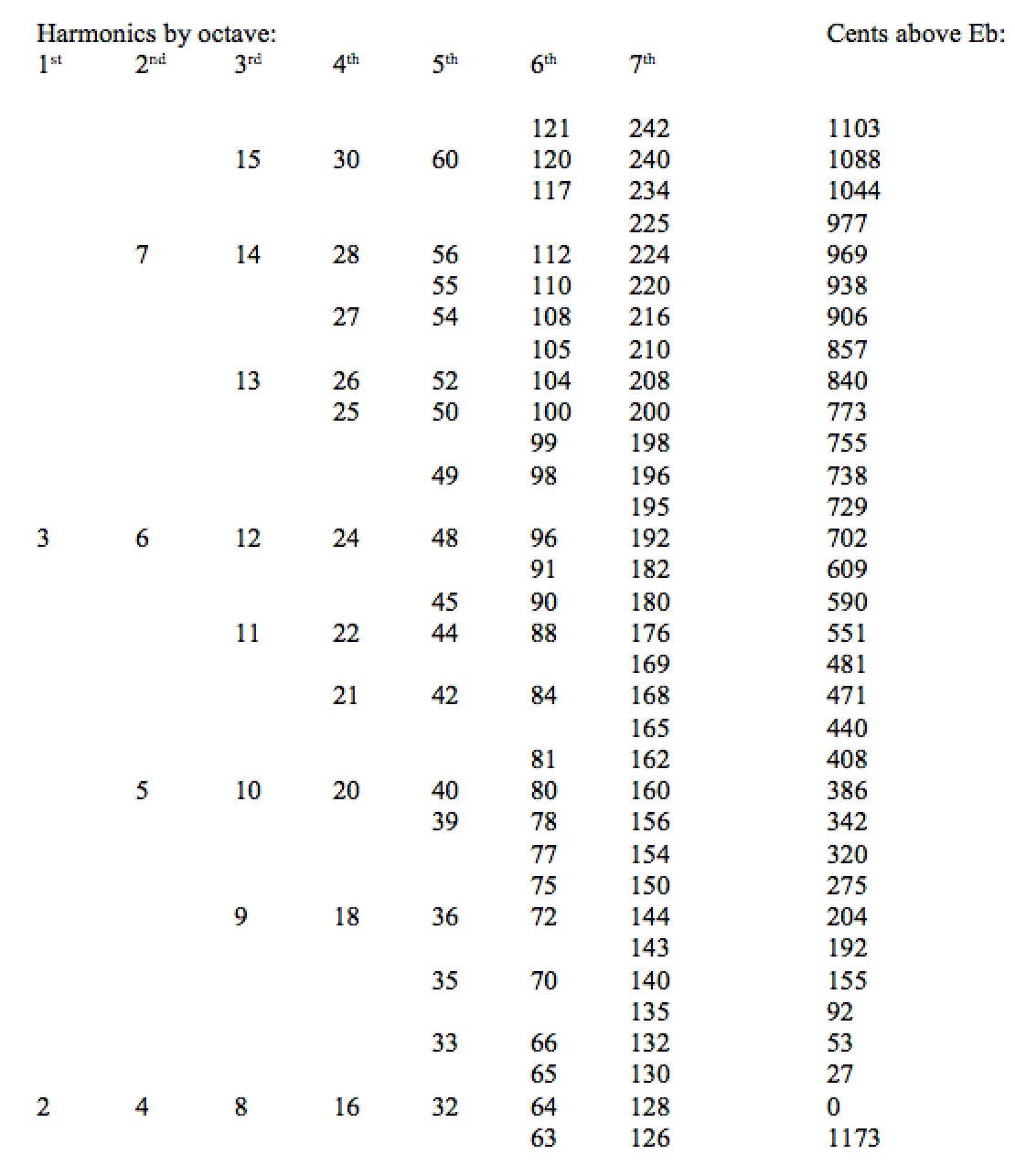Over the course of my long career in microtonality, I have been drawn more and more to the harmonic series as an efficient compendium of fertile pitch relationships. Finally, in writing Hyperchromatica for three retuned Disklaviers, I worked entirely in the harmonic series for more than two years. Some comments about the piece have shown that musicians misunderstand what I set out to accomplish in that piece, so I am moved to give some further technical explanation here. The piece is written in what I call my 8x8 scale, made up of harmonics of Eb: starting with the 1st, 3rd, 5th, 7th, 9th, 11th, 13th, and 15th harmonics of Eb and then building a similar harmonic series on each of those notes, as charted below.
Andromeda Memories
A lot of people have given thought to the thorny problem of whether jazz can be performed in just intonation, or in other tunings at all. Jazz syntax seems particularly wedded to the twelve-tone-equal scale, since so many chord changes depend on (sometimes multiple) pivot notes: for instance, the tritone substitution in which the E and Bb of a C7 chord are assumed equivalent to the E and A# of an F#7 chord. For Andromeda Memories, Hyperchromatica's first movement, I decided to see how many plausible ii-V and ii-V-I progressions I could find in my segment of the harmonic series to simulate jazz syntax with. I had been working with the 8x8 scale for two years, and in looking through it again I finally realized that any hope of jazz syntax in it would have to center around the pitch D (15/8) and its dominant A+ (45/32). Below is the chart of the entire scale correlated to its eight constituent harmonic series. Even though Eb is the fundamental pitch, see if you can catch what distinguish D and A+ among the 33 pitches:
Did you get it? D and A+ are the only pitches that occur in four different harmonic series. D is also the 1st, 3rd, 5th, and 15th in its respective series, which means that it participates in minor, dominant, and major seventh chords, the three chords necessary to create any semblance of jazz harmony:
as 1 in the D series, it can be the root of a major or dominant seventh;
as 5 in the Bb series, it can be the root of a minor seventh or the third of a Bb major or dominant 7th;
as 3 in the G series it can be the third of a B minor seventh or fifth of a G major or dominant;
and as 15 in the Eb series it is the seventh of an Eb major seventh.
D is also one of only two pitches in the 8x8 scale which can be the root of a major, minor, and dominant seventh; the other is G. D, then, is one of the scale's most versatile pitches, unlike the fundamental Eb, which is part of only one harmonic series. I realized, then that my ii-V-I progressions would center heavily around D, and secondarily G. (You might have thought I would have a ii-V-I in the basic key of Eb, F-Bb-Eb, but actually the F harmonic series has no 6/5 Ab, and so no seventh chord on F can be minor.)
And so I start nonchalantly on a purely tuned D minor seventh chord. A G7 could have followed, but it was much more mysterious to use its tritone sub. In conventional tuning that would be Db, but here it was D7b, the seventh harmonic of Eb. On a regular piano, a Db7 following a Dm7 would retain the pivot note F. But the F in this Dm7 is 9/8, and the F that's the major third of the seventh harmonic (5 x 7) is 35/32. 9/8 = 36/32, and so the F actually drops about a quarter-tone, a 36/35 ratio.
The relationship sounds conventional enough, but the two chords actually have no pitches in common. (Note the 49th harmonic, C77b+, at 738 cents.) Later (mm. 23-24, starting at 2:10 on the recording), in a melody that recurs, a Bm7 chord moves to a Bbmaj7 (B going to Bb by sixth-tones through that 49th harmonic), the root descending only 71 cents as the melody's B ascends 133 cents to a C+, the ninth of the Bbmaj7. It's an ear-twisting ii-I progression, parallel to the Dmin7-Db7, but with smaller intervals and a seeming quarter-tone split in the voice-leading. The three types of seventh chord keep the jazz references clear, but the harmony keeps returning to D to start over again - because from D there are more logical routes to take.
Non-musicians get Andromeda Memories because they recognize the mellow jazz style, but also register the peripheral pitch differences which make the chord progressions strangely fresh and different. Musicians not trained in microtonality, though, may assume that I just took some standard jazz progressions and tuned them perfectly; had I done only that, it might have been easy indeed, though the number of pitches might have multiplied precipitously, and the harmonic series structure keeps them limited. Instead, within 33 fixed pitches of a single harmonic series I ferreted out every chord movement that might remind the ear of conventional jazz progressions: something like taking a massive Rubik's Cube and twisting its colors into geometric patterns. Microtonalists will know that you don't simply shake a harmonic series and have ii-V-I's fall out. The piece sounds improvised and unpredictable in its movements, but was achieved within an extremely rigid set of pitch limitations.
Busted Grooves
Sliding between major and minor is a permanent feature in my musical style (inherited from William Duckworth, actually), and microtonally I love to mediate the minor third going to major third via an in-between quarter-tone, 11/9:
In my 8x8 scale, however, this configuration never appears, and I missed it. (Every scale has its drawbacks.) One day I noticed (and almost every movement started with some theoretical insight about the scale I hadn't noticed before) that I had an even more smoothly mediating in-between pitch:
There's that invaluable 49th harmonic of Eb again, mediating between the 48th (3rd) harmonic Bb and the 50th (25th) B-natural, even more smoothly than 11/9 would have. The 49/40 was a neutral third only in the key of G in this tuning, and so I immediately started Busted Grooves in the only possible key of G. You can hear minor pass to major and back through 49/40 at the very opening of the piece, and it continues as an ostinato, also appearing in many melodies.
There was also, however, one other key in which the 11/9 made an appearance, in the key of F+, where the minor third was not 6/5, but the septimal minor third of 7/6 (267 cents). So at one point (mm. 100-101, 5:20 on the recording), as a kind of harmonic-structural joke, I let the music wander into F+, with a 7/6-11/9-5/4 progression:
The ear gets the quasi-transposition, but I think only the theorist gets the joke.
Pavane for a Dead Planet
This pavane (for all its occasional rhythmic complexity) may seem an old-fashioned idiom to be writing in at this date, but I use it to effect a large-scale harmonic transformation that I've never seen used before. It would seem almost by definition that you can't find minor keys in the harmonic series, but I love them, and I decided to make minor scales by analogy to modes in the diatonic scale. That is, whereas the basic scale of the piece is 1/1, 9/8, 5/4, 11/8, 3/2, 13/8, 7/4, 15/8, I make a "harmonic series minor," or Phrygian, by starting on the third scale degree, giving me 1/1, 11/10, 6/5, 13/10, 7/5, 3/2, 8/5, 9/5. The harmonic series Phrygian of F+, then, begins on A+, that of Eb on G, that of D7b on F7+, and so on. The opening A section goes through the harmonic series (plural) on F+, Eb, D, and D7b. But when the same material returns in the second A section, I "transpose" it to the other four series: C13b, Bb, Ab^, G. In an equal-tempered scale this transposition would be unexceptional, but in an unequal scale all the voice-leadings between harmonies change somewhat. The tonic notes, in cents above Eb, are 590, 386, 275, 155 in the first section, and 65, 1088, 938, 773, in the second section, so the descent that was originally 204, 111, 120 cents is changed into 177, 150, 165 in the second. All the melodic connections between chords are a little altered. It's a conventional form, but I think the use of large-scale "transposition" in an unequal scale can be considered novel.
The 24-chord Sequence
Of the 8x8 scale's 33 pitches, 24 (excluding 169 = 13x13, 121 = 11x11 and so on) can be harmonized with pure major or minor triads. So (in Dark Forces Signify) I made a sequence of 24 chords based on the following top line moving through the following spacings in cents:
I rely on this sequence in several movements, particularly Ride the Cosmos, Rings of Saturn, Busted Grooves, and a little in Spacecat. Of course, not all the movements use triadic harmony, but (as Conlon Nancarrow discovered in the 1950s), triads form a perceptible and comprehensible way to thicken a contrapuntal line in a thick texture. The effect is hyperchromatically neo-Riemannian; Partch would have termed it "tonality flux."
Close Pitches
Some of the movements (Orbital Resonance, Star Dance, Pulsars) aim at getting beats from pitches extremely close together. Orbital Resonance opens with phased repetitions of the 65th and 66th harmonics, and closes with the 54th, 55th, and 56. Star Dance opens with the latter three, and makes its melodies from tones in the densest parts of the scale. Pulsars is composed of nothing but the harshest dissonances available, and lets them ring for fifteen seconds at a time for the beats to emerge. Its opening sonority is three low pitches on the 98th, 99th, and 100th harmonics, three pitches within 35 cents. The following chart groups the 33 harmonics according to their octave in the harmonic series on Eb, so that one can see at a glance where the closest pitches are.
I used this chart to navigate in these especially dissonant movements. Other movements (Liquid Mechanisms, Galactic Jamboree, Reverse Gravity) combine lines and textures from different harmonic series to experiment with just-intonation bitonality and polytonality.
* * * * * * * * * * * * * * * * *
I hope it will be clear from all this that the variety among the movements of Hyperchromatica derived explicitly from various insights I gained into the structure of the scale, and of the harmonic series in general. The longer I worked on it, the more new potentials I kept finding.
I write this further explanation partly to rebut criticisms from composers (never from anyone else) that I have anachronistically returned to historical styles. (Of course, postmodern composers such as Rochberg, Bolcom, Del Tredici, Zorn have been returning to historical styles since the 1980s; why this would still bring negative comment at this date eludes my comprehension.) Except occasionally in setting old poetry, I would never write in an old-fashioned idiom without introducing novelty in terms of tuning and polytempo innovations. The conservatism of the idioms throws the newness of the tuning concepts into relief, focusing the listener's ear on the strangeness of devices that were prohibited or impossible during the centuries music of these styles was originally written in. Non-musicians recognize this intuitively. As a former newspaper editor (and non-musician) wrote to me on hearing Hyperchromatica, "The underpinnings of it are, of course, utterly beyond me, so it's like listening to magic - simultaneously completely familiar and completely alien... To me... this is like a whole new world." That was certainly the intention.
Kyle Gann
Return to the Alternative Tunings page
